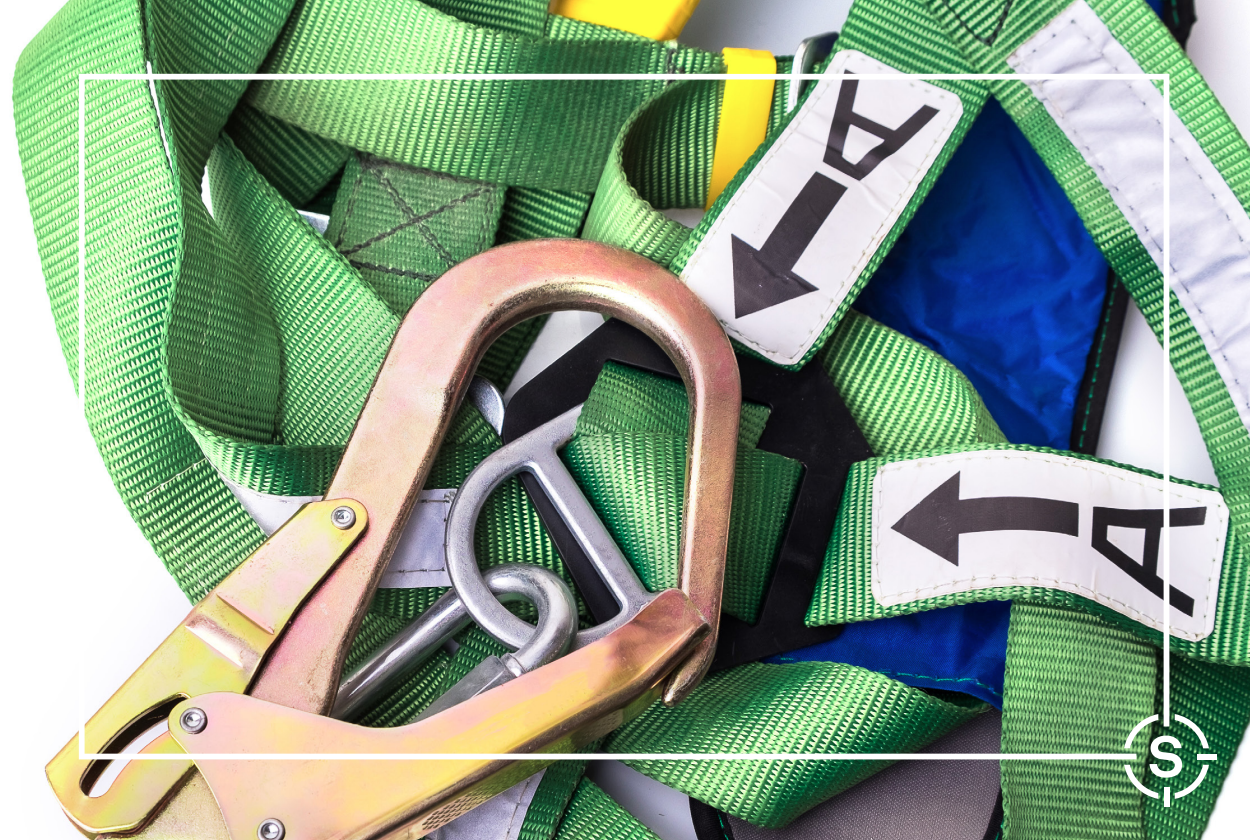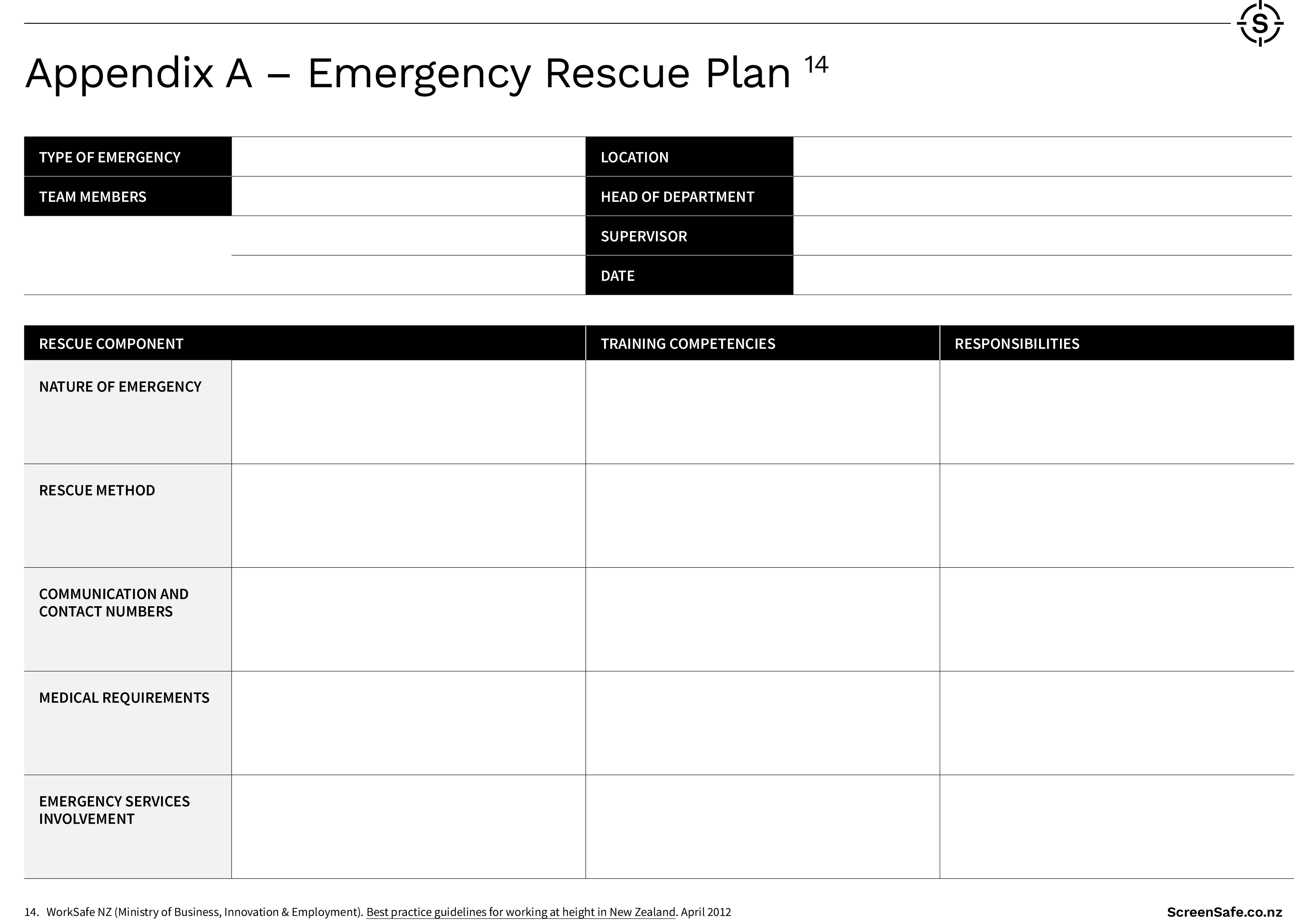This chapter provides guidance in relation to working
at height, and is primarily based on New Zealand
legislation and guidance issued by WorkSafe NZ.

All workers who undertake tasks at height should read and understand the section on ‘minimum responsibilities of working at height’.
Roles that have specific responsibilities, or influence, over setting up and managing work at height should read the section on ‘planning and guidance considerations and responsibilities’ – this includes producers, directors, line producers, production managers, art directors, construction managers, heads of departments, assistant directors and health and safety officers.
Work at height means working in a place where a person could be injured if they fell from one level to another.1 When considering working at height you must also consider and manage the risk/s associated with falling objects, if it is reasonably likely that the object would fall on and injure a person.2 There is no threshold for working at height; if someone or something could fall from one level to another and injure an individual then that is working at height. Work at height does not include slips, trips and falls at the same level.
What specific working at height risks are there on production sets?
These risks are further outlined in individual chapters.
Everyone who works at height on a screen production should read and understand this section, including grips, lighting crew, camera crew, special effects and art department crew. If you are responsible for, or have influence over, an activity or task where there is work at height, you should read and understand the following section on ‘planning and guidance considerations and responsibilities’.
All workers should:
Too many falls from height occur because of a failure to plan or organize work properly.
Everyone who is responsible for, or has influence over, an activity or task where there is work at height should read and understand this section, as well as the minimum responsibilities for everybody.
This includes the production company, producers, art directors, construction managers, line producers, heads of departments, assistant directors and health and safety officers.
Identifying the risk of working at height
Everyone who is responsible for an activity or task in relation to the production should consider the potential risks associated with working at height; this is where someone or something could fall from one level to another causing harm to an individual.
Ways of identifying such risks include:
HOW DO I ASSESS THE RISK OF WORKING AT HEIGHT?
Just like any health and safety risk you must assess it – thinking about:
Appendix 2: health and safety risk assessments process will help you undertake a risk assessment.
WHAT ARE OTHER RISKS THAT CAN IMPACT ON WORKING AT HEIGHT?
The potential risks associated with working at height can be compounded by other hazards. The following list is not exhaustive and a full risk assessment, by a competent person, should always be undertaken prior to work at height.
HOW DO I CONTROL THE RISK OF FALLS FROM HEIGHT?
First, you must consider whether you can eliminate the risk, if this is not reasonably practicable then you must minimize that risk – this is called the hierarchy of controls.
Appendix 2: health and safety risk assessments process will further help you understand how to use the hierarchy of controls.
Remember – the greater the risk, the greater the controls need to be. Doing nothing is not an option.
Elimination is the most effective control method.
You could eliminate the risk of working at height by:
Elimination can be best achieved at the design and construction planning stage. If complete elimination of the risk is not reasonably practicable, you must consider ways to minimize the risk starting by looking at how you could prevent a fall from occurring.
You could minimize the risk by preventing the fall through the use of:
If you cannot prevent a fall then you must look at ways to minimise the harm that could occur from a fall.
Minimising the distance and impact of a fall must only be considered after you’ve exhausted all elimination controls and minimisation controls that would have prevented the fall in the first place. You can minimise the distance and impact of a fall using:
WHAT’S THE DIFFERENCE BETWEEN GROUP CONTROLS AND PERSONAL CONTROLS?
As well as the hierarchy of controls, you need to think about controls that will protect multiple people. These are group controls, and the best methods to use as they that don’t require active judgement by individuals to keep themselves safe – for example scaffolding or a safety net.
Personal controls only protect the individual using the control and rely on the user using them correctly to ensure their safety
HOW DO I SELECT THE RIGHT EQUIPMENT TO USE?
When deciding what control to use, as well as considering the hierarchy of controls and group versus personal controls, you should also think about other factors that may affect the success of your controls.
Working conditions
Distance to be negotiated for access and egress
Distance and consequences of a fall
Duration and frequency of use
Rescue
Additional risk posed by the installation and removal of work equipment
WHAT TYPE OF CONTROLS COULD I USE?
There are many different types of controls that you could use for eliminating or minimising the
risks associated with working at height.
The primary controls used within the screen industry are detailed further risk-specific chapters.
Depending on the set circumstances, you may also wish to consider the below controls, you can
find out more information about these control methods in WorkSafe guidance.
Edge protection
Safety mesh
Harness systems
Temporary work platforms
Catch platforms
Soft landing systems
Safety nets
Fixed roof ladders
Ladders / step ladder
All working at height activities, where it has been identified that a fall would require a rescue mission or any potential harm, would require an immediate medical response should have a rescue plan.
Factors to be considered while developing a rescue plan include:
Adequate information and training on the rescue plan should be provided to those working at height, and any potential rescuers.
The rescue plan should be formally tested, before work commences, to ensure effectiveness.
Under no circumstances is a person to be used in suspended casualty emergency drills. The drills should be simulated using a mannequin or other suitable method.
A rescue plan template can be found in appendix A.
The rescue plan should be formally tested, before work commences, to ensure effectiveness.
Funders should:
In pre-production, production companies (likely to have primary responsibility over health and safety on the production) should:
As these roles have oversight across these elements of production, they should (during pre-production and the production):
The assistant director/s should ensure the potential risks associated with working at height are discussed with all cast and crew during health and safety inductions and / or as required if circumstances on the set change.
The health and safety officer should ensure potential risks associated with working at height are discussed with all cast and crew during health and safety inductions and / or as required if circumstances on the set change.
Insufficient training for the task being carried out is one of the primary contributing factors to injuries caused by working at height.
As part of all PCBUs primary duty of care to provide and maintain a safe and health work environment, they must ensure workers have had the necessary training to allow them to undertake their work safely.
Anyone who has direct oversight of a worker undertaking a working at height task should ensure they are adequately trained and competent in their work. This will often be the head of department.
Things to think about include, does the worker have:
Or do they require:
WorkSafe’s guidance outlines the levels of compliance and competency required for specific working at height tasks and control.
Insufficient training for the task being carried out is one of the primary contributing factors to injuries caused by working at height.
General considerations relating to working at height are listed below. This is a broad overview of things to consider and should not substitute a full risk assessment of the production set.


ScreenSafe is not a hotline for specific Health & Safety issues or concerns, please direct these to your Health & Safety representative or WorkSafe
For more information about any of the initiatives ScreenSafe is working on please speak to your relevant Guild representative or contact info@screensafe.co.nz
© 2016 | Created by Green Chilli Design